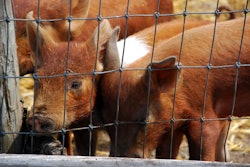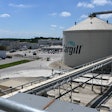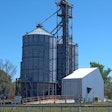Grain, feed, and seed facilities are often faced with a dirty situation when designing dust collection for rail car and truck dump pits. Designing a dump pit with good dust collection in mind not only addresses the dirty situation but can save you operational time and money.
这些应用程序的传统除尘includes local hoods that capture nuisance dust using large volumes of air that are then transferred to a remote baghouse dust collector. With an integrated point-of-use dust collector, nuisance dust from the grain or seed is still captured at the pit, but it can remain with the primary grain in the pit, eliminating any need for a duct system to a large remote baghouse dust collector. Designed correctly, integrated dust collection can save potentially 25% to 50% of installed cost compared to traditional remote baghouse dust collection.
In facilities that utilize several dump pits, a centralized system pulls air from all dump pits, even if only a few are active. With a-point-of-use system, air extraction (and the energy costs for operating fans) is only performed for the active pits. Inactive pits are left idle, rather than adding unnecessary air volume to the centralized dust system capacity.
Integrated point-of-use dust collection uses the same slotted baffles as traditional dump pit systems to control airflow at the dump pit opening. While grain is loaded into the pit, baffles swing open to allow grain to enter while leaving much of the unused pit area closed. After loading is completed, the baffles return to a closed position to restrict nuisance dust from exiting the pit. Point-of-use collectors stationed on either side of the pit create a slight negative pressure in the pit to capture nuisance dust. Dust pulsed from the filters during operation returns back into the pit and exits with the process grain stream.
Ideally, point-of-use collectors should be integrated into the original layout of the dump pit, but there is often space on one or both sides of existing pits to accommodate the installation of smaller point of use collectors. Once integrated, this method of dust collection provides many cost savings and maintenance benefits.
Reclaiming grain
Grain pulled into the waste stream of conventional baghouse dust collection is often lost. It can sometimes be introduced back into a process stream with bucket elevators or conveyors, but these represent added capital and operational costs. Further, if more than one type of commodity is processed at a facility, the mixture from a traditional baghouse collector may complicate return to the process stream. Point-of-use collectors eliminate this complication as they keep grain and dust within the original process stream.
Significant savings
Besides saving product otherwise destined to become part of a waste stream, point-of-use collectors can save both capital and installation expense, while having a positive impact on operational cost.
Because point-of-use collectors only see short duration surges of loading, a few smaller collectors replace the traditional large baghouse. Shipping costs for smaller point-of-use collectors are often much less, and eliminating ductwork lowers installation costs substantially compared to traditional remote dust collection. In addition, the reduction in ducts will reduce fan static requirements, allowing selection of smaller, less expensive fans and controls.
Of the potential costs in a dump pit process, yearly energy consumption offers the most notable cost avoidance when considering point-of-use dust collection. As an example, a pit measuring 10 feet by 25 feet in a conventional design might require a fan with as much as 155 HP. A point-of-use collector approach would require smaller fans totaling only 115 HP. At an estimated $0.15 per kilowatt, and assuming the pit is running 24 hours a day, the yearly operating cost for a conventional baghouse system totals about $167,000, while the the lower horsepower point-of-use system totals only $123,900. In this example, the facility would save approximately $43,000 a year.
减少停机时间
As a final consideration, look at the down-time consequences on a facility when filters finally need to be serviced or replaced. A traditional baghouse will require several workers to enter the collector for filter replacement (often considered a permit-required confined space). By contrast, filters in point-of-use collectors are typically changed with relative ease from outside the collector, with filter replacement typically only requiring a single worker. The units in our earlier example could be fully serviced in just a couple of hours.
As one can see, designing a dump or rail pit dump station, with a point-of-use dust collection approach at an early stage will address a dirty situation while allowing you to save money both initially and throughout the operating life of the resulting system.
For more information, visit www.donaldson.com.





















